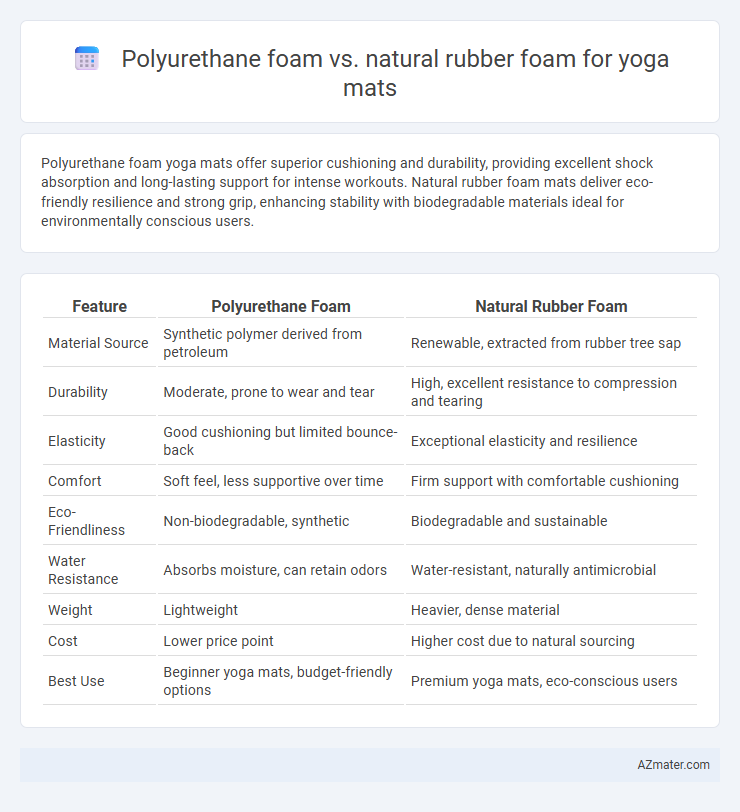Polyurethane foam yoga mats offer superior cushioning and durability, providing excellent shock absorption and long-lasting support for intense workouts. Natural rubber foam mats deliver eco-friendly resilience and strong grip, enhancing stability with biodegradable materials ideal for environmentally conscious users.
Table of Comparison
| Feature | Polyurethane Foam | Natural Rubber Foam |
|---|---|---|
| Material Source | Synthetic polymer derived from petroleum | Renewable, extracted from rubber tree sap |
| Durability | Moderate, prone to wear and tear | High, excellent resistance to compression and tearing |
| Elasticity | Good cushioning but limited bounce-back | Exceptional elasticity and resilience |
| Comfort | Soft feel, less supportive over time | Firm support with comfortable cushioning |
| Eco-Friendliness | Non-biodegradable, synthetic | Biodegradable and sustainable |
| Water Resistance | Absorbs moisture, can retain odors | Water-resistant, naturally antimicrobial |
| Weight | Lightweight | Heavier, dense material |
| Cost | Lower price point | Higher cost due to natural sourcing |
| Best Use | Beginner yoga mats, budget-friendly options | Premium yoga mats, eco-conscious users |
Introduction to Yoga Mat Materials
Polyurethane foam and natural rubber foam are two popular materials used in yoga mats, each offering unique benefits for practitioners. Polyurethane foam provides excellent cushioning, durability, and moisture resistance, making it suitable for high-impact exercises and sweaty sessions. Natural rubber foam is prized for its eco-friendly properties, superior grip, and natural elasticity, appealing to environmentally conscious users seeking a sustainable yet comfortable yoga experience.
Overview of Polyurethane Foam
Polyurethane foam, widely used in yoga mats, offers excellent durability, high resilience, and superior cushioning compared to natural rubber foam. It is manufactured through a chemical process that creates a lightweight, closed-cell structure, providing better moisture resistance and longevity. This foam type is favored for its ability to maintain shape over time, making it ideal for intense yoga practices requiring strong support and comfort.
Overview of Natural Rubber Foam
Natural rubber foam stands out for its exceptional elasticity, durability, and eco-friendly composition, making it a preferred material for premium yoga mats. Derived from the sap of rubber trees, it offers superior cushioning and resilience that effectively absorbs impact during rigorous yoga sessions. Its biodegradability and natural resistance to mildew and bacteria contribute to a healthier practice environment compared to synthetic alternatives like polyurethane foam.
Eco-Friendliness and Sustainability
Natural rubber foam offers superior eco-friendliness and sustainability compared to polyurethane foam due to its renewable sourcing from rubber trees and its biodegradability. Polyurethane foam, derived from petrochemicals, poses environmental challenges with non-renewable resource use and limited recyclability. Choosing natural rubber foam for yoga mats significantly reduces ecological impact and supports sustainable production practices.
Comfort and Cushioning Comparison
Polyurethane foam offers superior cushioning due to its dense cellular structure, providing excellent support and shock absorption ideal for yoga mats targeting comfort during prolonged poses. Natural rubber foam delivers a softer, more responsive feel with high elasticity, promoting enhanced comfort through better contouring to the body's movements. While polyurethane foam excels in durability and impact resistance, natural rubber foam outperforms in natural resilience and eco-friendly qualities, making it a preferred choice for comfort-focused yoga practitioners.
Durability and Longevity
Polyurethane foam offers superior durability and resistance to wear, making it ideal for high-use yoga mats that maintain cushioning over time. Natural rubber foam, while providing excellent elasticity and natural resilience, tends to degrade faster under consistent stress and exposure to moisture. For users seeking long-lasting yoga mats with sustained performance, polyurethane foam typically outperforms natural rubber foam in terms of longevity and structural integrity.
Grip and Slip Resistance
Polyurethane foam offers excellent grip due to its dense and slightly tacky surface, enhancing slip resistance during dynamic yoga poses. Natural rubber foam provides superior traction with its inherent elasticity and textured surface, preventing slips on both dry and sweaty mats. Both materials excel in grip, but natural rubber foam typically outperforms polyurethane in slip resistance for a more stable practice.
Maintenance and Cleaning
Polyurethane foam yoga mats require moderate maintenance, as they tend to absorb moisture and odors, necessitating regular wiping with mild soap and air drying to prevent mold and mildew. Natural rubber foam mats offer easier cleaning with just water and gentle detergent, thanks to their closed-cell structure that resists moisture and dirt penetration, making them less prone to odor buildup. Both materials benefit from avoiding prolonged exposure to direct sunlight to maintain elasticity and prevent cracking over time.
Price and Value Considerations
Polyurethane foam yoga mats generally offer a lower price point compared to natural rubber foam, making them an affordable choice for budget-conscious consumers. Despite the lower cost, polyurethane foam provides moderate cushioning and durability but may lack the eco-friendliness and resilience found in natural rubber alternatives. Natural rubber foam mats, though priced higher, deliver superior value through enhanced grip, durability, and biodegradability, appealing to environmentally aware practitioners seeking longer-lasting performance.
Choosing the Best Foam for Your Yoga Practice
Polyurethane foam for yoga mats offers excellent durability, high density, and firm support ideal for robust practices like Power Yoga or Ashtanga, enhancing joint protection and balance. Natural rubber foam provides superior eco-friendliness, exceptional grip, and natural cushioning, suited for Yin Yoga, Hatha, or restorative sessions emphasizing comfort and sustainability. Selecting between polyurethane and natural rubber foam depends on practice intensity, environmental values, and desired texture for optimal performance and long-term use.

Infographic: Polyurethane foam vs Natural rubber foam for Yoga mat
 azmater.com
azmater.com